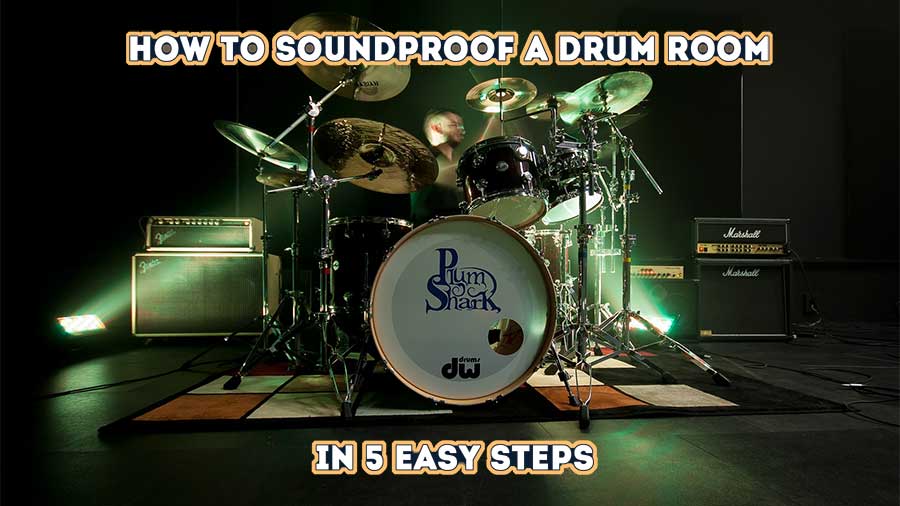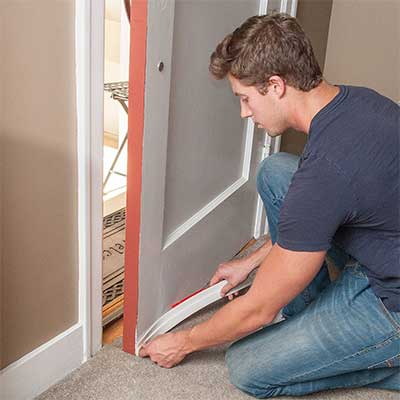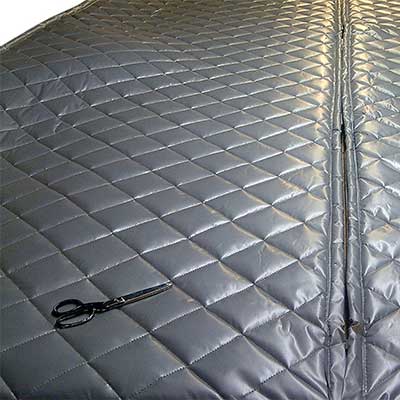On stage, the powerful punch of a drumset is everything but when practicing, the powerful punch of a drumset is usually too much, especially for others nearby. You’ll see a lot of tips out there for how to soundproof a room for drums.
Unfortunately, a lot of these don’t help all that much.
To truly soundproof a room, you need to be willing to spend a ton of money and put forth a whole lot of effort. You’ll essentially need to do a full remodel project for your drum room.
But if you don’t have the cash or the energy for such a project, you don’t have to worry. There is a lot that you can do to drastically reduce the sound that gets out of your drum room. This is achieved primarily through sound absorption.
Below are the 5 best ways to help deaden the sound in a room for drums. All of these steps are pretty easy to implement and they won’t break the bank.
Step 1: Find the leaks.
Sealing a room off completely with no air flow in or out of the room probably isn’t a good idea because, inside the room, it will get hot and stuffy.
But sealing off as many of the big air leaks as possible will do a lot to reduce the sound. After all, if air can get through from inside the room to outside the room, so can that drumming noise.
Start with the door.
Be a leak detective.
Go around the room searching for leaks. Use your eyes but perhaps even more importantly, your sense of touch. Feel for air flow. This isn’t a super fun process but you’ll probably be surprised by just how many little leaks you find. Seal up the leaks with some Foam Seal Tape or even caulk.
Step 2: Further reinforce the door.
Unless you’re living in an older home with solid wood doors, chances are good that your door is hollow.
This actually helps to amplify the sound which is the opposite of what you want. Reinforcing the door with something like the Singer Safety Double Faced Quilted Fiberglass Panel will do a lot to minimize the amount of sound that bleeds through the door itself.
If the price for the Singer panel is a bit too steep for you and you don’t mind a less pleasing look, you can also just screw or glue a big piece of wood to the door. A few sheets of Jack Richeson Medium Density Untempered Hardboard would do the trick.
Step 3: Buy a good Drum rug.
Placing a rug underneath the drumset will do a lot to soak up some of the sound. There are rugs designed especially for this purpose, like the Meinl Cymbals MDR-BK Drum Rug.
This rug is designed in a way that helps spurs and stands dig into so you don’t have to worry about enthusiastic drumming causing any movement or tipping. If black is a bit too boring for you, you can go with an oriental rug design like the Meinl Cymbals MDR-OR Drum Rug.
The rug should ideally be laid on top of a floor that is already carpeted. If your room isn’t carpeted, you’ll want to either install carpeting or cover the entire floor with rugs.
Step 4: Add acoustic foam to the walls and ceiling.
What makes drums sound extra loud is when there are hard surfaces for the sound to bounce off of.
The walls and the ceiling of your room create an effect where the sound ricochets back and forth from one hard surface to another. This effectively amplifies the sound.
One way to reduce this ricochet effect is to cover the walls and even the ceiling with acoustic foam.
This can actually end up looking pretty cool if you want it to. You can buy acoustic foam in different colors and different designs. This lets you arrange them in unique and artistic ways if desired.
Diamond-style panels like these Acoustic Foam Sound Absorption Wall Panels are a good option. These panels reduce the reverb and echo that makes you sound louder. To cover the whole surface, you’ll need to buy several packs. They are available in several colors so you can mix it up or just keep it simple with one color. If you can’t afford enough to cover the whole area, covering even 25% of the walls and ceiling will make a difference. The more surface you can cover, the better, but even a few panels will help.
Step 5: Cover windows with thick drapes.
If you’re worried about too much sound getting outside in addition to within the rest of the house, you’ll want to do something about your windows. After sealing up any leaks, your best bet is to buy some thick drapes or curtains.
Blackout curtains will usually also be pretty effective at blocking sound but there are some drapes that specifically feature noise-reducing thermal insulation as well.
These NICETOWN Blackout Curtains Panels are a good choice. Luckily, they are available in several colors, so you can choose ones that will go with your acoustic foam panels if desired.
Conclusion
Will these five steps completely soundproof your drum room? No, but they will do a lot and your drum noise will be significantly reduced.
Most drummers find that this more affordable process is all they need. That said, it’s also important to remember to be considerate.
If you and/or your band practices while other people are in the house or are nearby, try to be thoughtful about your practicing. Choose practice times that are respectful of others and always remember to let them know in advance when you’ll be practicing.





Hi,
great article! Are you still working on this site?
Are the window tapes cover the light?
This seems to be a perfect solution for my drum rum, thanks dude could you please suggest few accessories cover the same for my study room.
I’m confused about how a hollow door could amplify sound… Sure it will let more sound escape than a solid door but it would be defying the laws of physics by ‘amplifying the sound’.
Also foam and drum rugs are great for dampening the inflexions of sound within a room (good for recording etc.) but in my experience they do very little to sound proof a room.
I completely agree with the sentiment of trying to block leaks though, that is an effective method to try. Really though if you’re looking to limit the amount of sound escaping a room instead of acoustically treat a space I would first be looking at:
-Trying to isolate the kit from the floor and joists of the house
-Get as much rockwool around that kit in every direction as possible!
-If on a complete budget get a sheet of 18mm ply or mdf bolted to the door
Thanks for the guide though 🙂
It works in the same way a drum shell or guitar body would.
Hollow doors resonate more…..like drums
The reason a hollow core door “might” amplify certain sound frequencies is because as the sound waves travel thru the door some of those sound waves will rebound back and forth inside the door. The amplification can occur when those sound waves start to synch and start to create harmonic frequencies (where the peaks of the wave are larger). One way to visualize it may be to think about a lake where there are boats going and their wakes at times come together creating a larger wave.
Like a lot of basements, mine has a window-well with a small window. Would recommend fitting a piece of foam to fill the window sill, plus the heavy drapes too?
The amplification comes from air moving around. You want to stop the air from moving. A hollow door will work like a speaker because the air is hitting the back side. So denser doors makes sense. You can allso hang a piece of Molton in front of the door. Molton is super dense and absorbs sound waves. And it is rather affordable. Also works well for windows.
If you have a hollow-core door you can drill through the didn’t side and inject the lightweight expanding foam but do not use the regular expanding foam use the door and window foam this will fill the void and make the door more dense without damage